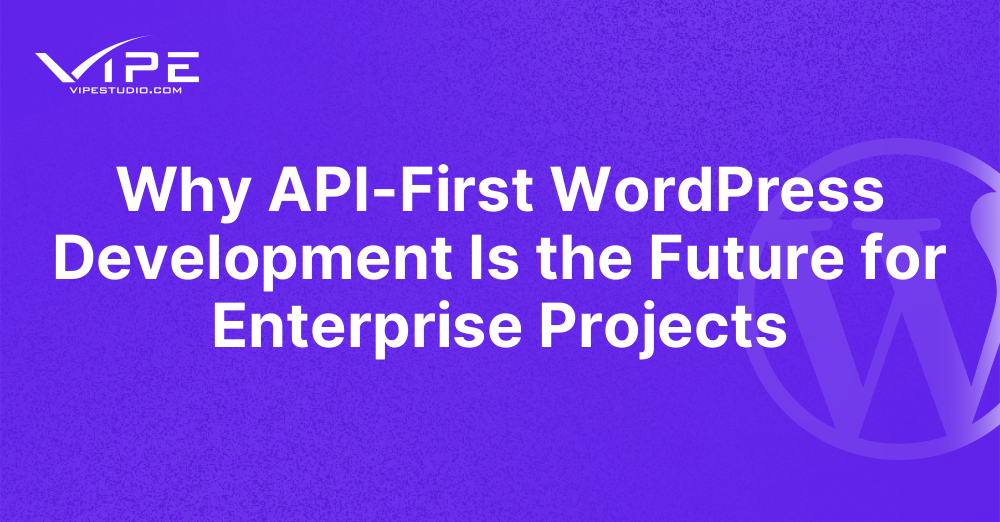14.05.2025
WordPress Development
Why API-First WordPress Development Is the Future for Enterprise Projects
READING TIME: MIN
Table of Content
As enterprise businesses demand more from their digital platforms—greater flexibility, real-time integration, and multi-channel presence—traditional WordPress development approaches can start to show their limitations. Enter API-first WordPress development: a methodology that decouples the frontend from the backend and treats APIs as the central interface for delivering content, features, and services. This approach is revolutionizing how large-scale projects are built with WordPress.
Traditional WordPress vs. API-First WordPress: Understanding the Shift
In classic WordPress setups, the frontend and backend are tightly integrated—content is rendered directly using PHP templates within the same environment. While this is fine for smaller sites, it limits flexibility when building complex, scalable, or multi-platform digital experiences.
With API-first WordPress development, the backend focuses purely on content management and data, while frontend applications consume this data via REST or GraphQL APIs. This opens the door to using JavaScript frameworks like Next.js, Nuxt, or React Native to build fast, modern, and platform-agnostic interfaces.
The Strategic Advantages of API-First WordPress in Large Projects
Enterprises benefit greatly from decoupling their architecture. Here’s why API-first is becoming the go-to approach:
- Platform independence: Content managed in WordPress can be displayed on websites, mobile apps, kiosks, and more.
- Performance gains: Modern frontend frameworks can pre-render pages, drastically improving speed and SEO.
- Scalability: API-first design allows you to scale backend and frontend layers independently.
- Security: Exposing only APIs and keeping the WordPress admin hidden reduces attack surfaces.
At Vipe Studio, we’ve adopted this architecture for many enterprise WordPress projects that require speed, flexibility, and integration with other internal systems.
Using WordPress as a Headless CMS Through REST or GraphQL APIs
WordPress offers a built-in REST API, and with the help of plugins like WPGraphQL, developers can also query content using GraphQL, which is often preferred for its efficiency and flexibility. With these tools, developers can fetch only the data they need, avoid over-fetching, and build highly dynamic interfaces.
For example, you can build a single-page application (SPA) in React that dynamically updates content without reloading pages—all while managing content centrally in WordPress.
Real-Time Integrations and Microservices for Business Logic
Enterprises often operate in complex ecosystems involving CRMs, ERPs, marketing automation platforms, and analytics tools. API-first WordPress makes it easier to integrate with these services. Whether it’s pushing form submissions to HubSpot or syncing product data with an internal database, APIs allow seamless communication between systems.
With a microservices-friendly approach, you can modularize your backend processes and extend functionality without affecting the core WordPress environment.
Developer Workflow and DevOps Benefits
API-first architecture enables better CI/CD pipelines. Developers can work on frontend and backend codebases separately, enabling faster iteration and less risk of deployment conflicts. Teams can also use modern development tools like GitHub Actions, Vercel, and Docker to automate testing and deployment processes.
This also means you can switch out your frontend stack or redesign the UI without having to rework your backend data structure—future-proofing your technology decisions.
Challenges and Considerations Before Going Headless
Despite its advantages, API-first WordPress does come with a few trade-offs:
- Initial setup and infrastructure can be more complex.
- Some native WordPress features like menus and previews require extra configuration in a decoupled setup.
- Your development team should be proficient in frontend frameworks and API integrations.
But for enterprise-scale applications, the long-term benefits usually outweigh the initial complexity. With the right architecture and experienced development partner, these challenges can be managed effectively.
Conclusion: API-First Is Not Just a Trend—It’s a Foundation
API-first WordPress development represents a major shift in how enterprise-grade websites and digital platforms are being built. It’s not just a trend—it’s a necessity for businesses seeking scalability, speed, flexibility, and integration readiness in their web presence.
If you’re looking to transition your WordPress project to an API-first or headless architecture, contact Vipe Studio for tailored enterprise solutions that align with your digital transformation goals.
More on The Topic
- The Admin UX That Shapes Decisions
- Scaling WordPress Without Losing Culture
- WordPress 6.9 “Gene”: What This Release Really Changes
- Managing Gutenberg Chaos at Scale
- The Real Difference Between Managed and Developer-Oriented Hosting
The content of this website is copyrighted and protected by Creative Commons 4.0.



